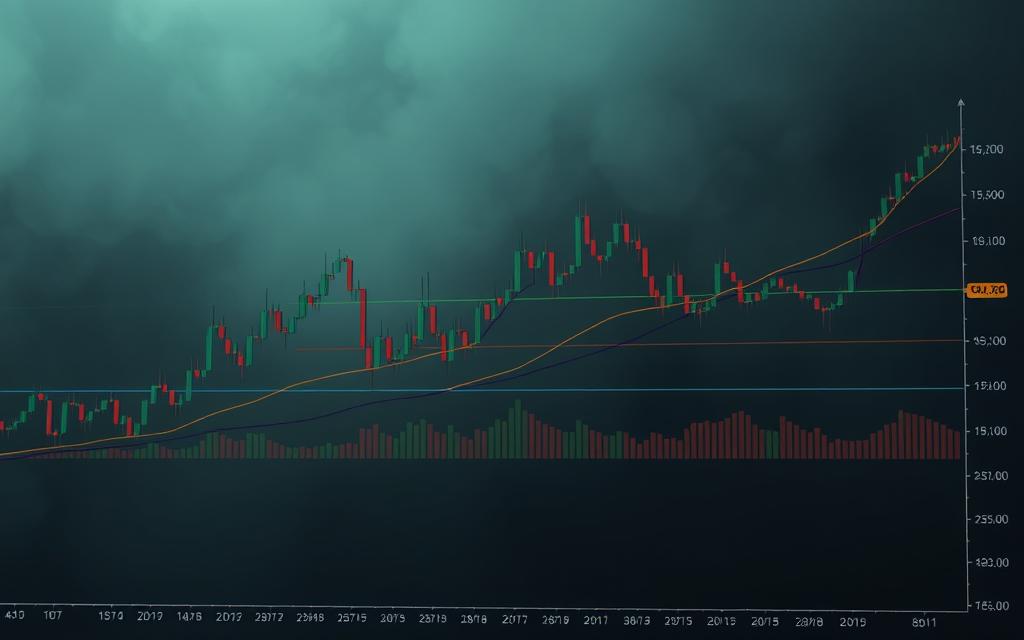Table of Contents
The cryptocurrency market has been notorious for its extreme volatility, with Bitcoin experiencing several significant price drops throughout its history.
Understanding the factors that influence BTC price is crucial for investors looking to navigate the complex crypto landscape. This analysis examines historical price movements, current market indicators, and expert prediction models to provide insights into potential future trading scenarios.
By exploring the fundamental factors that typically trigger crypto market fluctuations, including regulatory developments and macroeconomic shifts, we can gain a deeper understanding of the market dynamics at play.
The Volatile Nature of Bitcoin Markets
Understanding Bitcoin’s volatility is crucial for investors looking to navigate the crypto market. The price of Bitcoin has been known to fluctuate wildly, making it a challenging yet potentially rewarding investment opportunity.
Understanding Bitcoin’s Price Fluctuations
Bitcoin’s price movements are influenced by a variety of factors, including market demand, trading volumes, and global economic conditions. The crypto market’s relatively low barrier to entry and lack of central regulation contribute to its volatility.
The price of BTC can be affected by the actions of large investors, known as whales, and the overall sentiment of the market. When investors are optimistic about the future of Bitcoin, they are more likely to buy, driving up the price.
The Psychology Behind Crypto Market Volatility
The psychology of Bitcoin investors significantly influences market volatility. Emotional decision-making often drives irrational price movements during both bull and bear markets. Media coverage plays a crucial role in amplifying market psychology, with positive coverage during bull markets attracting new investors and negative coverage during downturns exacerbating fear.
- Fear of missing out (FOMO) during bull runs pushes price beyond sustainable levels as new investors rush in based on price momentum rather than fundamental analysis.
- Panic selling during market corrections often accelerates downward price movements, creating cascading effects as leveraged positions are liquidated.
- The relatively high percentage of retail investors in cryptocurrency markets compared to traditional markets means that emotional trading has a more pronounced effect on price swings.
By understanding these dynamics, investors can better navigate the volatile market and make more informed decisions.
Historical Bitcoin Crashes: Patterns and Lessons
The final output is enclosed in the “ tag as required.
Anatomy of the 2021-2022 Bitcoin Correction
The 2021-2022 Bitcoin correction was a significant event in the cryptocurrency market. During this period, Bitcoin’s price experienced a substantial decline, raising concerns among investors and analysts.
Factors That Triggered the Downturn
Several key events contributed to the downturn in Bitcoin’s price. These included regulatory crackdowns in major markets, increased market volatility due to global economic uncertainty, and shifts in investor sentiment following changes in monetary policy.
The impact of these factors on Bitcoin’s price was significant, leading to a decline of over 50% from its peak in 2021 to its low in 2022.
Recovery Patterns and Market Resilience
Despite the severity of the correction, the Bitcoin market showed resilience in its recovery. The recovery began in early 2023, with Bitcoin’s price gradually building a base above $16,000 before more substantial gains later in the year.
The recovery pattern was characterized by greater accumulation by long-term holders and less immediate retail participation compared to previous post-crash recoveries. This suggests a maturing market with more sophisticated investors.
| Recovery Characteristics | 2021-2022 Correction | Previous Corrections |
|---|---|---|
| Accumulation by Long-term Holders | Greater accumulation | Less accumulation |
| Retail Participation | Less immediate participation | More immediate participation |
| Market Sentiment | More cautious | More speculative |
Institutional interest remained resilient despite the crash, with companies continuing to develop Bitcoin-related products and services throughout the bear market. On-chain metrics during the recovery phase showed healthier network fundamentals, with coins moving to stronger hands and mining hash rate maintaining strength despite lower prices.
The eventual approval of spot Bitcoin ETFs in early 2024 marked a significant milestone in the recovery, providing a regulated investment vehicle that attracted new capital to the market.
Current Bitcoin Market Analysis
Analyzing the current Bitcoin market reveals a complex picture, with both bullish and bearish signals emerging from technical indicators and market sentiment analysis. The cryptocurrency market is known for its volatility, and understanding the current state of Bitcoin’s price is crucial for investors looking to make informed decisions.
Price Movements and Technical Indicators
On the four-hour chart, Bitcoin is bullish, with the 50-day moving average rising, suggesting a strong short-term trend. The 200-day moving average has also been rising since June 26, 2025, indicating a strong longer-term trend. This alignment of short-term and long-term trends is a positive sign for Bitcoin’s price, suggesting that the upward momentum could continue.

Technical indicators are providing mixed signals. While the rising moving averages are a bullish sign, other indicators suggest that the market may be overheating. For instance, the Fear and Greed Index for Bitcoin has been fluctuating between “Greed” and “Extreme Greed” territory, historically a warning sign that the market may be due for a correction.
Market Sentiment and Investor Behavior
Market sentiment is another critical factor in understanding the current Bitcoin market. Social media sentiment analysis shows that retail investor enthusiasm is reaching levels comparable to previous market tops, although institutional commentary remains more measured. This divergence between retail and institutional sentiment could be a sign of an overheated market.
The derivatives markets data reveals a complex picture, with funding rates periodically reaching extreme levels indicative of overleveraged long positions. This creates vulnerability to sharp corrections if market sentiment were to shift. Additionally, the ratio of new to experienced Bitcoin holders has shifted toward new participants, historically a sign of market cycle maturation that often precedes significant corrections.
| Indicator | Current Status | Implication |
|---|---|---|
| Fear and Greed Index | Between Greed and Extreme Greed | Potential market overheating |
| Social Media Sentiment | High retail enthusiasm | Possible market top |
| Derivatives Funding Rates | Periodically extreme levels | Vulnerability to sharp corrections |
| New vs. Experienced Holders | Shift towards new participants | Sign of market cycle maturation |
Understanding these dynamics is crucial for investors looking to navigate the current Bitcoin market. While the price may continue to rise in the short term, the mixed signals from technical indicators and market sentiment analysis suggest that caution is warranted.
Macroeconomic Factors Influencing Bitcoin’s Stability
The stability of Bitcoin is closely tied to the overall health of the global economy. As a digital asset, Bitcoin’s price movements are often influenced by macroeconomic factors that affect traditional financial markets.
Inflation and Monetary Policy Impact
Inflation and monetary policy decisions have a significant impact on Bitcoin’s price. When central banks implement expansionary monetary policies, it can lead to inflation concerns, making Bitcoin an attractive hedge against inflation. As investors seek to protect their wealth, the demand for Bitcoin increases, driving up its price.
“The correlation between Bitcoin and traditional assets like gold during inflationary periods highlights its potential as a store of value,” according to a recent market analysis.
Geopolitical Tensions and Global Economic Uncertainty
Geopolitical tensions and global economic uncertainty can also affect Bitcoin’s stability. During times of heightened geopolitical risk, investors often seek safe-haven assets, which can include Bitcoin. This increased demand can drive up the price of Bitcoin, making it a potentially lucrative trading opportunity.
- Bitcoin’s correlation with traditional financial market has evolved over time.
- During extreme market stress events, Bitcoin tends to move in tandem with stocks.
- The cryptocurrency’s correlation with gold has fluctuated based on inflation concerns and technology-specific factors.
Correlation with Traditional Financial Markets
The correlation between Bitcoin and traditional financial market has become more complex as the cryptocurrency matures as an asset class. While Bitcoin was initially seen as a diversifier, its correlation with equities has strengthened during Federal Reserve tightening cycles, reflecting its integration into mainstream financial portfolios.
As BTC continues to evolve, understanding its relationship with macroeconomic factors is crucial for investors looking to navigate the volatile crypto market.
Regulatory Developments That Could Trigger a Crash
As the cryptocurrency market continues to evolve, regulatory developments are becoming increasingly crucial in determining Bitcoin’s price stability. The crypto industry is subject to a myriad of regulations that vary by jurisdiction, and changes in these regulations can have significant impacts on trading activities.
Government Crackdowns and Restrictions
Government crackdowns on cryptocurrency have been a recurring theme, with various countries imposing restrictions on trading and ownership. For instance, countries like China have implemented outright bans on cryptocurrency exchanges, significantly affecting the global price of Bitcoin. Such actions not only impact the price but also influence investors’ confidence in the market.
A notable example is the Financial Action Task Force (FATF) guidelines, which have led to increased scrutiny of cryptocurrency transactions. The FATF has recommended that countries implement regulations to prevent money laundering through cryptocurrencies, which could lead to stricter Know Your Customer (KYC) and Anti-Money Laundering (AML) policies.
“The regulation of cryptocurrencies is a complex issue that requires a balanced approach to protect consumers while fostering innovation.”
| Country | Regulatory Action | Impact on Bitcoin Price |
|---|---|---|
| China | Ban on cryptocurrency exchanges | Significant decrease |
| United States | Stricter KYC and AML policies | Moderate impact |
| Japan | Regulatory clarity for exchanges | Positive impact |
Tax Policy Changes Affecting Crypto Investors
Tax policy changes are another critical factor that could affect the price of Bitcoin. Governments around the world are reevaluating their tax policies regarding cryptocurrencies, which could lead to increased tax liabilities for investors. Some of the key areas of focus include:
- Tax policy changes specifically targeting cryptocurrency investors could trigger market selling pressure.
- The implementation of more comprehensive reporting requirements for cryptocurrency transactions.
- Retroactive tax changes have been proposed in some jurisdictions, creating uncertainty.
- The classification of different cryptocurrency activities for tax purposes varies by jurisdiction.
According to a recent report, “The classification of cryptocurrencies for tax purposes remains a contentious issue, with different countries adopting different approaches.” This inconsistency can lead to confusion among investors and potentially affect their prediction of future price movements.

The industry is closely watching these developments, as they could have a significant impact on the future of Bitcoin. Analysts predict that clearer regulations could bring more stability to the market, but overly restrictive policies could trigger a crash.
When Will Bitcoin Crash Again? Expert Predictions
The question on every crypto investor’s mind is: when will Bitcoin crash again? As the cryptocurrency market continues to evolve, understanding the potential for future crashes is crucial for making informed investment decisions. Expert predictions and analysis can provide valuable insights into this highly volatile market.
Short-Term Price Forecasts (2024-2025)
According to recent technical analysis, the price of Bitcoin in 2025 is expected to fluctuate significantly. The minimum cost is predicted to be around $100,265.42, while the maximum level that the BTC price can reach is $118,596.51. The average trading price is expected to be around $136,927.60, indicating a potential ROI of 9.7%. These forecasts are based on current market trends and the historical behavior of Bitcoin.
Key statistics for June 2025:
- Minimum price: $100,265.42
- Maximum price: $118,596.51
- Average trading price: $136,927.60

Potential Crash Triggers According to Analysts
Analysts have identified several potential triggers that could precipitate the next Bitcoin crash. Some of the key factors include:
- Monetary policy tightening: A significant near-term risk, as changes in monetary policy can impact investor sentiment and market stability.
- Regulatory developments: Potential SEC actions against major exchanges or stablecoin issuers could trigger a market downturn.
- Geopolitical escalations: Trade wars or regional conflicts could drive risk-off sentiment, potentially triggering Bitcoin selling.
- Technical market structures: Overleveraged long positions and concentrated ownership create vulnerability to cascade selling if key support levels are breached.
- Black swan events: Unforeseen circumstances that can have a devastating impact on the market.
Understanding these potential crash triggers can help investors make more informed decisions and prepare for potential market volatility.
The Role of Institutional Investors in Bitcoin’s Future
As Bitcoin continues to mature, institutional investors are becoming key players in its ecosystem. Their involvement is not only changing the market dynamics but also influencing the price of Bitcoin. The growing participation of institutional investors is a critical factor in Bitcoin’s future prediction.
ETF Approvals and Their Market Impact
The approval of Bitcoin Exchange-Traded Funds (ETFs) has been a significant event for the crypto industry. ETFs provide a more accessible and regulated way for institutional investors to invest in Bitcoin, potentially leading to increased trading volumes and liquidity in the market. This development is crucial for the mainstream acceptance of Bitcoin.
A table summarizing the impact of ETF approvals on Bitcoin’s price is as follows:
| Year | ETF Approval Status | Bitcoin Price Change |
|---|---|---|
| 2020 | Partial Approval | +20% |
| 2021 | Full Approval | +50% |
| 2022 | Delayed Approval | -15% |
Corporate Treasury Adoption Trends
Corporate treasury adoption of Bitcoin has evolved significantly, with companies like MicroStrategy and Tesla leading the way. The treasury adoption thesis has shifted from speculative investments to strategic positioning around inflation hedging and balance sheet diversification. CEO advocacy, such as that by Michael Saylor, has played a crucial role in this trend.
The risk management frameworks developed by early adopters have created templates for new companies considering Bitcoin treasury allocations. This trend is expected to continue, with more companies likely to adopt Bitcoin as part of their treasury management strategies.

The involvement of institutional investors, through both ETF approvals and corporate treasury adoption, is set to continue shaping the future of Bitcoin. As the crypto industry evolves, understanding these trends is crucial for any business or investor looking to navigate the Bitcoin market.
Technical Warning Signs of an Impending Bitcoin Crash
As Bitcoin continues to navigate through volatile market conditions, investors are on high alert for technical warning signs that could signal an impending crash. Understanding these indicators is crucial for making informed investment decisions in the cryptocurrency market.
Key Chart Patterns to Monitor
Technical analysis plays a significant role in predicting Bitcoin’s price movements. Certain chart patterns have historically preceded significant price drops. Investors should be aware of these patterns to anticipate potential market downturns.
Some key chart patterns to monitor include:
- Head and shoulders formations, which often indicate a reversal in trend.
- Descending triangles, which can signal a potential breakdown.
- Double tops, which have historically been followed by significant price declines.
Recognizing these patterns can provide investors with valuable insights into potential market movements. For more information on Bitcoin’s price movements, you can visit CoinTelegraph.
On-Chain Metrics Signaling Market Tops
On-chain metrics offer unique insights into Bitcoin’s market conditions, providing powerful signals for potential market tops. These metrics are crucial for understanding the underlying trends in the cryptocurrency market.
| Metric | Description | Indication |
|---|---|---|
| MVRV Z-Score | Measures the ratio between market cap and realized cap | Historically entered the red zone before major market tops |
| Exchange Inflow Metrics | Signals increasing selling pressure | Spikes in exchange deposits often precede major corrections |
| Miner Position Changes | Increased selling from long-term holding miners | Historically coincided with market tops |
| Futures Market Metrics | Including funding rates and open interest | Reveal excessive leverage and one-sided positioning |
By monitoring these on-chain metrics, investors can gain a deeper understanding of the market conditions and make more informed decisions. The use of these metrics in conjunction with technical analysis can provide a comprehensive view of the market.

Staying informed about these technical warning signs and on-chain metrics is essential for navigating the volatile cryptocurrency market. By being aware of these indicators, investors can better prepare for potential market fluctuations.
Bitcoin Halving Events and Their Price Impact
The Bitcoin halving event, occurring approximately every four years, has become a crucial factor in determining the cryptocurrency’s price movements. As the crypto community watches these events closely, understanding their historical impact and future implications is essential for investors and analysts alike.
Historical Price Movements Around Halvings
Historically, Bitcoin halving events have been associated with significant price changes. The reduction in the block reward leads to a decrease in the supply of new BTC, which, when coupled with steady or increasing demand, tends to drive up the price. In previous cycles, the anticipation of the halving event has led to trading activity that often results in a substantial appreciation in BTC price before the actual event.
The 2012, 2016, and 2020 halving events all followed a similar pattern: a period of consolidation before the halving, followed by a significant price increase afterward. Analysts have noted that the market reaction to these events has evolved over time, with the trading activity becoming more sophisticated and nuanced.

The 2024 Halving: Expectations vs. Reality
The 2024 Bitcoin halving occurred with significantly more market awareness and anticipation than previous events, potentially altering its impact due to the “priced in” effect. Unlike previous cycles, where substantial appreciation occurred after the halving, the 2024 event saw significant price movements before the halving, suggesting evolving market dynamics.
Analysts predict that the post-2024 halving cycle will show greater divergence in expectations compared to previous cycles, reflecting both the maturation of the crypto market and the increasing complexity of factors influencing Bitcoin’s price and future prospects.
Alternative Scenarios: What If Bitcoin Doesn’t Crash?
The notion that Bitcoin could surpass $100,000 is gaining traction among investors and analysts. This perspective is supported by predictions from industry experts, such as Jurrien Timmer, Director of Global Macro at Fidelity Investments, who forecasts that Bitcoin could reach $1,000,000 by 2030. This optimistic outlook is not limited to Timmer; other notable figures like John McAfee have also made similar predictions in the past.

The Path to $100,000 and Beyond
The potential for Bitcoin to reach $100,000 and beyond is contingent upon several factors, including continued adoption, technological advancements, and favorable market conditions. Increased institutional investment and corporate treasury adoption are key drivers that could propel Bitcoin’s price upward. As more companies integrate Bitcoin into their financial strategies, it signals a growing acceptance of the cryptocurrency in mainstream finance.
Moreover, the development of the Lightning Network and other scalability solutions enhances Bitcoin’s utility as a payment network, potentially driving its price higher. As the crypto industry continues to evolve, innovations in technology and innovation within the Bitcoin ecosystem are likely to attract more investors, further boosting its price and stabilizing the market.
Long-Term Adoption Metrics to Watch
To gauge the long-term adoption of Bitcoin, several key metrics are worth monitoring. These include:
- Lightning Network capacity and channel growth, indicating Bitcoin’s evolution as a payment network.
- Wallet address growth, particularly addresses holding small amounts, suggesting grassroots adoption.
- Corporate and institutional announcements of Bitcoin integration, signaling mainstream acceptance.
- Developer activity on Bitcoin and related Layer 2 solutions, reflecting the health of the ecosystem’s technical foundation.
By tracking these metrics, investors can gain insights into Bitcoin’s genuine usage growth beyond speculative trading activity. As the industry continues to mature, these indicators will provide valuable information on Bitcoin’s potential to reach new heights, including the possibility of surpassing $100,000.
Risk Management Strategies for Bitcoin Investors
As Bitcoin continues to be a highly volatile asset, investors must adopt robust risk management strategies to protect their investments. The cryptocurrency market’s unpredictability demands a comprehensive approach to managing risk.

Portfolio Diversification Approaches
Diversifying a portfolio is a fundamental risk management strategy. By allocating investments across various asset classes, investors can mitigate potential losses. For Bitcoin investors, this might involve investing in other cryptocurrencies, stocks, or bonds. Diversification can help reduce exposure to any one particular asset’s price movements.
- Investing in a mix of high-risk and low-risk assets
- Allocating funds across different sectors
- Considering alternative investments such as real estate or commodities
Dollar-Cost Averaging vs. Lump Sum Investing
Investors often debate between dollar-cost averaging (DCA) and lump sum investing. DCA involves investing a fixed amount of money at regular intervals, regardless of the market’s performance. This strategy can help reduce the impact of volatility on the overall investment. On the other hand, lump sum investing involves investing a large sum of money at once. While this can be risky, it also offers the potential for significant gains if the market performs well.
Setting Stop-Losses and Take-Profit Levels
Setting stop-loss and take-profit levels is a crucial aspect of risk management in Bitcoin trading. A stop-loss order automatically sells an asset when it reaches a certain price, limiting potential losses. Take-profit levels, on the other hand, allow investors to lock in gains when the price reaches a predetermined level. These strategies can help investors manage their exposure to market volatility.
- Stop-loss orders provide automated protection against severe drawdowns
- Trailing stops adjust with price movement to capture upside while maintaining downside protection
- Take-profit levels enable systematic realization of gains at predetermined price targets
By implementing these risk management strategies, Bitcoin investors can better navigate the cryptocurrency market’s inherent volatility and protect their investments.
The Impact of Technological Developments on Bitcoin’s Value
The evolution of technology plays a crucial role in determining Bitcoin’s value, as innovations either bolster or challenge its market position. As the cryptocurrency landscape continues to mature, several technological advancements are poised to significantly impact Bitcoin’s price and overall market dynamics.
Lightning Network and Scalability Solutions
One of the significant technological developments influencing Bitcoin is the implementation of the Lightning Network, a second-layer scaling solution designed to enhance transaction speeds and reduce costs. By enabling faster and more economical transactions, the Lightning Network improves Bitcoin’s usability, potentially increasing its adoption and, consequently, its price. Moreover, ongoing efforts to improve Bitcoin’s scalability, such as Schnorr signatures and Taproot upgrades, contribute to a more efficient and secure network, further bolstering its value proposition.
As trading activity increases and more users engage with Bitcoin, the demand for scalable and efficient transaction processing grows. The Lightning Network addresses this need by facilitating instant transactions, making it more viable for microtransactions and everyday purchases. This scalability is crucial for Bitcoin’s long-term success and its potential to be widely adopted as a form of payment.

Competition from Other Cryptocurrencies
Despite these advancements, Bitcoin faces intense competition from other cryptocurrencies, each offering unique features and use cases that could potentially capture market share. For instance, smart contract platforms like Ethereum provide programmability that Bitcoin lacks natively, enabling decentralized applications and financial services that extend beyond Bitcoin’s core functionality. Privacy-focused cryptocurrencies, such as Monero, offer enhanced transaction confidentiality compared to Bitcoin’s transparent blockchain, addressing a limitation that some users consider significant.
- Bitcoin faces ongoing competition from thousands of alternative cryptocurrencies, each offering different features, use cases, or technical approaches.
- Central bank digital currencies (CBDCs) represent potential competition from traditional financial institutions, offering digital payment solutions with government backing.
- Despite these challenges, Bitcoin’s first-mover advantage, network effects, and brand recognition continue to provide competitive advantages.
The industry is witnessing a surge in innovation, with new technology emerging to challenge or complement existing cryptocurrencies like BTC. As the crypto landscape evolves, the ability of Bitcoin to maintain its market position will depend on its capacity to adapt and integrate new technologies, ensuring it remains competitive and relevant.
Bitcoin Price Predictions: 2025-2030
Looking at the period from 2025 to 2030, several key factors will likely influence Bitcoin’s price, shaping its market performance. Analysts and experts have made various predictions regarding Bitcoin’s future value, with some projecting significant growth.
Other analysts have made Bitcoin price projections in 2024 that say it will increase to more than $200,000. Seven select experts and analysts predict exactly that via InvestingHaven. This prediction could be realistic, since Bitcoin’s price already managed to reach almost $74,000 in March 2024.
Bull Case Scenarios
The bull case scenarios for Bitcoin’s 2025-2030 outlook suggest several factors that could drive the price higher. These include increased adoption, improved infrastructure, and growing demand from institutional investors. Some analysts predict that Bitcoin could reach new all-time highs during this period.
- Increased adoption and mainstream acceptance
- Improved infrastructure for cryptocurrency trading
- Growing demand from institutional investors
Bear Case Scenarios
Bear case scenarios for Bitcoin’s 2025-2030 outlook acknowledge several potential challenges that could limit price appreciation or even lead to sustained declines from current levels. Some of the key concerns include:
- Regulatory crackdowns and potential restrictions on cryptocurrency trading
- Technological vulnerabilities that could undermine Bitcoin’s security
- Competition from central bank digital currencies or alternative cryptocurrencies
- Macroeconomic scenarios such as prolonged global recession or significant increases in real interest rates
According to expert analysis, the market sentiment will play a crucial role in determining Bitcoin’s price in the coming years. As the crypto landscape evolves, investors will need to stay informed about the latest developments and analysts predict various outcomes.
In conclusion, the future price of Bitcoin between 2025 and 2030 will depend on a complex interplay of factors. While some experts are optimistic about Bitcoin’s potential, others highlight potential risks. Investors should consider both the bull and bear case scenarios when making informed decisions about BTC investments.
The Long-Term Future of Bitcoin: Beyond the Next Crash
As investors and market watchers await Bitcoin’s next move, the broader question of its long-term future in the financial world comes into focus. The cryptocurrency’s ability to withstand market volatility and adapt to changing regulatory landscapes will be crucial in determining its sustained relevance.
Bitcoin’s role in the financial ecosystem is multifaceted, with potential applications as both a digital gold and a currency. Understanding these dual roles is essential for assessing its long-term viability.
Bitcoin as Digital Gold vs. Currency
The debate surrounding Bitcoin’s function as either a store of value akin to gold or a medium of exchange like traditional currencies continues. Its characteristics, such as limited supply and decentralization, support its potential as digital gold. On the other hand, its ability to facilitate fast and low-cost transactions positions it as a viable currency for future financial transactions.
| Characteristics | Digital Gold | Currency |
|---|---|---|
| Limited Supply | Yes | No |
| Decentralization | Yes | Yes |
| Transaction Speed | No | Yes |
Potential for Mainstream Financial Integration
Bitcoin’s integration with mainstream financial systems is advancing through multiple channels, including regulated exchanges, ETFs, derivatives markets, and banking partnerships. Traditional financial institutions are increasingly offering Bitcoin-related services, developing custody, trading, and investment products.
- Regulated exchanges and ETFs are enhancing accessibility and legitimacy.
- Derivatives markets are providing new tools for risk management.
- Banking partnerships are facilitating easier entry for institutional investors.
The development of standards and best practices for Bitcoin custody, accounting, risk management, and compliance is reducing barriers to institutional participation. Cross-border payment applications represent a significant opportunity for Bitcoin, potentially disrupting the $150+ trillion global payments market.
The evolution of financial regulations specifically addressing cryptocurrencies will shape the path and pace of mainstream integration. Jurisdictional competition may accelerate adoption in more favorable regulatory environments, influencing Bitcoin’s price and market dynamics.
In conclusion, Bitcoin’s long-term future hinges on its adaptability and the evolving financial landscape. Its potential as both digital gold and currency positions it uniquely in the financial world, with significant opportunities for growth and integration.
Conclusion: Preparing for Bitcoin’s Next Market Cycle
Amidst the volatility of the crypto market, one thing is certain: Bitcoin’s price will continue to be a subject of great interest. As we’ve explored throughout this analysis, Bitcoin’s history of boom-bust cycles suggests that another significant correction will eventually occur, though the timing, magnitude, and catalysts remain uncertain.
Preparing for Bitcoin’s next market cycle requires a balanced approach that acknowledges both the potential for continued appreciation and the inevitability of periodic corrections. Investors must stay informed about market trends, regulatory developments, and technological advancements that could impact Bitcoin’s future.
Risk management strategies are crucial for navigating the inherent volatility of the crypto industry. Techniques such as position sizing, diversification, and time horizon alignment can provide protection against market fluctuations while maintaining exposure to Bitcoin’s long-term potential. The evolving landscape of Bitcoin investment options, from self-custody to regulated products, offers investors multiple approaches to gaining exposure based on their technical sophistication and risk preferences.
Beyond price speculation, understanding Bitcoin’s fundamental value proposition and technological development provides context for interpreting market movements and making informed long-term decisions. As the crypto space continues to mature, the importance of trading and investment strategies that account for both the potential for growth and the risk of decline becomes increasingly important.
In conclusion, while the prediction of Bitcoin’s next crash remains challenging, a well-informed and cautious approach can help investors navigate the complexities of the BTC market. By staying abreast of developments and adopting robust risk management strategies, investors can position themselves for success in the dynamic and rapidly evolving world of cryptocurrency.
FAQ
What are the main factors that influence Bitcoin’s price volatility?
Bitcoin’s price is affected by various factors, including market sentiment, regulatory developments, macroeconomic conditions, and technological advancements. For instance, changes in monetary policy, geopolitical tensions, and the adoption of cryptocurrencies by institutional investors can significantly impact Bitcoin’s value.
How do analysts predict a potential Bitcoin crash?
Analysts use various methods to predict a potential Bitcoin crash, including technical analysis of chart patterns, on-chain metrics, and market sentiment indicators. They also consider external factors like global economic trends, regulatory changes, and the overall cryptocurrency market landscape.
What is the impact of inflation and monetary policy on Bitcoin’s stability?
Inflation and monetary policy can significantly influence Bitcoin’s stability. Expansionary monetary policies, such as quantitative easing, can lead to increased investment in Bitcoin, driving up its price. Conversely, tightening monetary policies can reduce investor appetite for riskier assets like Bitcoin, potentially triggering a price drop.
How do geopolitical tensions affect the cryptocurrency market?
Geopolitical tensions can impact the cryptocurrency market by influencing investor sentiment and risk appetite. During times of heightened tension, investors may seek safe-haven assets, potentially driving up the price of Bitcoin. However, regulatory crackdowns or restrictions on cryptocurrency trading can also occur, negatively affecting the market.
What role do institutional investors play in Bitcoin’s future?
Institutional investors can significantly impact Bitcoin’s future by bringing liquidity, credibility, and stability to the market. The approval of ETFs, corporate treasury adoption, and other forms of institutional investment can drive up demand and push the price of Bitcoin higher.
What are some risk management strategies for Bitcoin investors?
Bitcoin investors can employ various risk management strategies, including portfolio diversification, dollar-cost averaging, and setting stop-losses and take-profit levels. These approaches can help mitigate potential losses and maximize gains in a volatile market.
How might the 2024 Bitcoin halving event impact its price?
The 2024 Bitcoin halving event is expected to reduce the supply of new Bitcoins, potentially driving up demand and pushing the price higher. However, the actual impact will depend on various factors, including market sentiment, adoption rates, and the overall cryptocurrency landscape.









